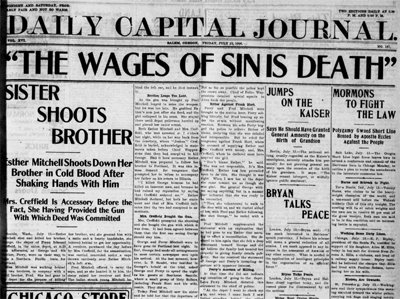“Holy roller” cult ended with murder, suicide, insanity
Bride of Christ cult sought perfect righeousness, Christ-like simplicity and total humility. In practice, though, it spawned nothing but misery and madness, and a legal precedent for “honor killings.”

F. Edmund Creffield in prison, to which he had been sent for a two-year
sentence after being convicted of adultery with a follower in 1904.
(Image: Oregon State Archives, penitentiary records)
By Finn J.D. John — June 5, 2011
Downloadable audio file (MP3)
In the autumn of 1904, F. Edmund Creffield was sentenced to two years in prison.
As a practical matter, though, the sentence might as well have been death. When Creffield emerged from prison after serving his term, it was a completely different world that waited for him outside. And by "different," I do not mean "better."
Creffield, founder of the most hard-core "holy roller" church in history, had been convicted of adultery for having sex with one of his female followers, 23-year-old Donna Mitchell Starr. He told the court it was part of a God-ordered purification ritual.
It still isn't known for sure if he thus "purified" any other women in his cult. But everybody outside his secretive little group instantly assumed he had.
A congregation of women
By the time the adultery charge was made, nearly all the men had left the Bride of Christ Church, leaving only Creffield and one other man as leaders of a flock of exclusively women — women who, following Creffield's instructions, had cut off all relations with their "infidel" husbands, friends and children. Now they were locked away from their loved ones, out of the community's sight, having placed themselves under the authority of a man who, as it now appeared, saw nothing wrong with adultery.
And remember, the cult was rumored to believe in staying naked all the time. This rumor was almost certainly groundless and based on the perceived inadequacy (by Edwardian-era standards) of the "simple garment" believers wore, but people believed it and it was definitely a factor.
To outsiders, Creffield's flock was looking more and more like a harem, and less and less like a congregation. The husbands of women in Creffield's flock now considered themselves not just cut off from marital relations, but cuckolded to boot. Older brothers assumed their little sisters had been sexually initiated. Men — at least three, probably more — started buying guns and making plans to use them.
The game starts turning deadly
The first attempt on Creffield's life happened in Yaquina City, near Newport. Creffield had returned to Corvallis just long enough to collect his scattered flock back together and lead them out of town. As had Moses so many years before, he was going to lead his people into the wilderness — a patch of unimproved woodland near Waldport, on the coast — and God would take care of them there.

This postcard image from the 1920s shows the entrance to the Oregon
State Penitentiary, where cult leader F. Edmund Creffield served 16
months of a two-year sentence for adultery
. [Larger image: 1200 x 756]
Among the women in Creffield's flock at the time he went to prison were Cora Hartley and her daughter Sophia. When Creffield was locked away, the two of them came home to Cora's husband, Louis Hartley, with whom they'd had nothing to do after joining the church — he was, after all, an unbeliever, and believers were not supposed to consort with the damned.
Louis obviously was not happy when Creffield, fresh from the slammer, strolled into town and called for his former flock to come follow him into the wilderness. Cora and Sophia answered the call immediately and started getting ready to go.
When the two of them left town on T. Edgenton Hogg's railroad line to Yaquina City and Newport to join their prophet by the sea, Louis secretively followed.
When he arrived in Yaquina City, Louis realized he'd lost their trail. (The two women had spotted him en route, and got off early at Toledo to shake him.) So he hopped a ferry to Newport and tried to find a judge who would order Creffield's arrest. None would.
So Hartley went to a sporting goods store instead. And with a brand-new .32-caliber revolver in his pocket, Hartley now started searching not for his family, but for Creffield.
The first attempt to kill Creffield

This .32-caliber Smith & Wesson pocket pistol is of the style and vintage
used by Louis Hartley in his attempt to assassinate F. Edmund Creffield
in Newport. Around the turn of the century, small and weak five-shot
pocket
revolvers like this one were very common and made by numerous
gun manufacturers; many Americans carried one habitually, like we do
cell phones today.
(Image: www.smith-wessonforum.com) [Larger
image:
800 x 599 px]
Eventually, not finding his quarry in Newport, Hartley boarded the ferry and returned to Yaquina City. And as the ferry he was on was docking, he saw another ferry just getting ready to depart — and his wife and daughter were standing on the stern. With Creffield.
Hartley leaped from his ferry and raced to the other just as it pulled away from the slip. He drew his revolver and opened fire on Creffield, who stood on the ferry facing him, a few yards away.
Five clicks rang out. The bullets Hartley had bought with the pistol were the wrong type for the gun; he'd loaded the rimfire pistol with centerfire ammo.
Creffield becomes hard to find
Although he put a good face on it at the time, Creffield seems to have taken this lesson to heart. From then on he was a hard man to find, always on the move. He led his flock to the "wilderness" camp, but didn't stay long; when Hartley returned with a Winchester rifle to try again, he found his prey long gone.
Over the following few months, Creffield's itinerant lifestyle frustrated at least one other would-be assassin, and probably more.
The assassination

The Salem Capital Journal reported George Mitchell's successful assassination
of Creffield on its front page.
(Image: Univ. of Oregon Libraries) [Larger
image:
PDF of full front page]
But eventually Creffield ended up in Seattle. And it was in that city, at 7:10 a.m. on May 7, 1906, as he was walking down the street with Maud, that a fellow named George Mitchell walked up behind him with a pocket pistol and put a bullet into the back of his head.
Mitchell was the brother of two of Creffield's most devoted followers: Esther Mitchell and Donna Mitchell Starr. The latter, you'll remember, was the woman he was convicted of adulterously "purifying."
Mitchell, after the police arrived, quietly handed over his pistol. "I have only done my duty," he told the officers, according to police reports. "I came here to kill that man, as he ruined my two sisters, and I have completed my work."
The defense: An honor killing
The trial was something of a landmark for Seattle. There was widespread sympathy for Mitchell. For all practical purposes, his defense rested on something known as "the unwritten law," the one that says it's OK for a man to perpetrate what you might call an honor killing on the fellow who's "defiled" his wife or sister.
When the trial concluded, the jury found Mitchell not guilty – this in spite of the fact that he had admitted, in open court, to an action that fit the definition of "premeditated murder" with remarkable precision. Although the smart money had been on a "not guilty by reason of insanity" verdict, the word when it came was just plain "not guilty." Mitchell was a free man.
In finding this way, without invoking an insanity defense that would result in Mitchell spending some time in an asylum, the members of the jury no doubt thought they were doing him a favor. They were gravely mistaken.
Revenge: Another honor killing
A few days later, Mitchell met up with his sister Esther in a railroad depot for what other family members hoped would be a reconciliation of sorts. Instead, it turned into another execution. Esther shot her older brother in the back of the head with a pocket pistol, in almost exactly the same way he'd gunned down Creffield.

The Salem Capital Journal also reported Esther Mitchell's killing of her
brother in the railroad station after he was acquitted of murder charges
for gunning down Creffield .
(Image: Univ. of Oregon Libraries) [Larger
image:
PDF of full front page]
In the aftermath of this shocker, the newspaper reporters really wanted Esther to tell them God had told her to avenge Creffield's death, or that somehow a religious frenzy had made her do it. Instead, she told them two things:
First, she said, she was doing exactly what her brother had done. The law was inadequate to the task of punishing a murderer, as evidenced by the fact that he'd been acquitted despite having admitted in court that he did it. This was pretty similar to George's claim that he'd had to shoot Creffield because the law wouldn't keep him away from his sisters.
Secondly, she pointed out that George had done exactly what he'd accused Creffield of doing: branded her as a fornicator. She insisted that Creffield had never had sex with her. By making the statement that he had killed Creffield because he'd "ruined" his sisters, George had, in effect, "ruined" his sisters.
More death, insanity and chaos
At her trial, Esther Mitchell refused to try to claim insanity. The state forced it on her anyway, and committed her to an asylum. A few years later, out of the asylum and staying at a family friend's place, she took a massive dose of strychnine and died – following the example of the widowed Maud Hurt Creffield, who'd killed herself in the same manner shortly after the trial.
Even water, in excessive quantities, is a deadly poison. Perhaps the same is true of what Creffield and his faithful followers would call the Water of Life.
(Sources: Phillips, Jim, and Gartner, Rosemary. Murdering Holiness. Vancouver, BC: UBC Press, 2003; Holbrook, Stewart. Wildmen, Wobblies and Whistle Punks (ed. Brian Booth). Corvallis: OSU Press, 1992; Thompson, Lewis. "Nemesis of the Nudist High Priest," Startling Detective, March 1951)
TAGS: #BentonCounty #FritzCreffield #Jailbird #DonnaMitchellStarr #YaquinaCity #Waldport #CoraHartley #SophiaHartley #LouisHartley #GeorgeMitchell #EstherMitchell #Seattle #UnwrittenLaw #InsanityPlea #Suicide #StrychninePoisoning #HolyRollers #WILLAMETTEvalley #BENTONcounty #LINCOLNcounty
<< PART 1 -- Part 2 of 2 articles about the "Holy Rollers."


















